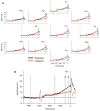Neural processes mediating the preparation and release of focal motor output are suppressed or absent during imagined movement
- PMID: 25744055
- PMCID: PMC4857718
- DOI: 10.1007/s00221-015-4237-5
Neural processes mediating the preparation and release of focal motor output are suppressed or absent during imagined movement
Abstract
Movements that are executed or imagined activate a similar subset of cortical regions, but the extent to which this activity represents functionally equivalent neural processes is unclear. During preparation for an executed movement, presentation of a startling acoustic stimulus (SAS) evokes a premature release of the planned movement with the spatial and temporal features of the tasks essentially intact. If imagined movement incorporates the same preparatory processes as executed movement, then a SAS should release the planned movement during preparation. This hypothesis was tested using an instructed-delay cueing paradigm during which subjects were required to rapidly release a handheld weight while maintaining the posture of the arm or to perform first-person imagery of the same task while holding the weight. In a subset of trials, a SAS was presented at 1500, 500, or 200 ms prior to the release cue. Task-appropriate preparation during executed and imagined movements was confirmed by electroencephalographic recording of a contingent negative variation waveform. During preparation for executed movement, a SAS often resulted in premature release of the weight with the probability of release progressively increasing from 24 % at -1500 ms to 80 % at -200 ms. In contrast, the SAS rarely (<2 % of trials) triggered a release of the weight during imagined movement. However, the SAS frequently evoked the planned postural response (suppression of bicep brachii muscle activity) irrespective of the task or timing of stimulation (even during periods of postural hold without preparation). These findings provide evidence that neural processes mediating the preparation and release of the focal motor task (release of the weight) are markedly attenuated or absent during imagined movement and that postural and focal components of the task are prepared independently.
Figures





Similar articles
-
The early release of planned movement by acoustic startle can be delayed by transcranial magnetic stimulation over the motor cortex.J Physiol. 2012 Feb 15;590(4):919-36. doi: 10.1113/jphysiol.2011.219592. Epub 2011 Nov 28. J Physiol. 2012. PMID: 22124142 Free PMC article. Clinical Trial.
-
When unintended movements "leak" out: a startling acoustic stimulus can elicit a prepared response during motor imagery and action observation.Neuropsychologia. 2013 Apr;51(5):838-44. doi: 10.1016/j.neuropsychologia.2013.01.016. Epub 2013 Jan 30. Neuropsychologia. 2013. PMID: 23376312
-
Reduced motor preparation during dual-task performance: evidence from startle.Exp Brain Res. 2015 Sep;233(9):2673-83. doi: 10.1007/s00221-015-4340-7. Epub 2015 May 31. Exp Brain Res. 2015. PMID: 26026810
-
Mental imagery in the motor context.Neuropsychologia. 1995 Nov;33(11):1419-32. doi: 10.1016/0028-3932(95)00073-c. Neuropsychologia. 1995. PMID: 8584178 Review.
-
Do imagined and executed actions share the same neural substrate?Brain Res Cogn Brain Res. 1996 Mar;3(2):87-93. doi: 10.1016/0926-6410(95)00033-x. Brain Res Cogn Brain Res. 1996. PMID: 8713549 Review.
Cited by
-
Investigating the Intervention Parameters of Endogenous Paired Associative Stimulation (ePAS).Brain Sci. 2021 Feb 12;11(2):224. doi: 10.3390/brainsci11020224. Brain Sci. 2021. PMID: 33673171 Free PMC article.
-
Influence of kinesthetic motor imagery and effector specificity on the long-latency stretch response.J Neurophysiol. 2019 Nov 1;122(5):2187-2200. doi: 10.1152/jn.00159.2019. Epub 2019 Sep 25. J Neurophysiol. 2019. PMID: 31553684 Free PMC article.
References
-
- Aruin AS, Shiratori T, Latash ML. The role of action in postural preparation for loading and unloading in standing subjects. Exp Brain Res. 2001;138:458–466. - PubMed
-
- Bakker M, de Lange FP, Stevens JA, Toni I, Bloem BR. Motor imagery of gait: a quantitative approach. Exp Brain Res. 2007;179:497–504. - PubMed
-
- Bakker M, De Lange FP, Helmich RC, Scheeringa R, Bloem BR, Toni I. Cerebral correlates of motor imagery of normal and precision gait. Neuroimage. 2008;41:998–1010. - PubMed
Publication types
MeSH terms
Grants and funding
LinkOut - more resources
Full Text Sources
Other Literature Sources

